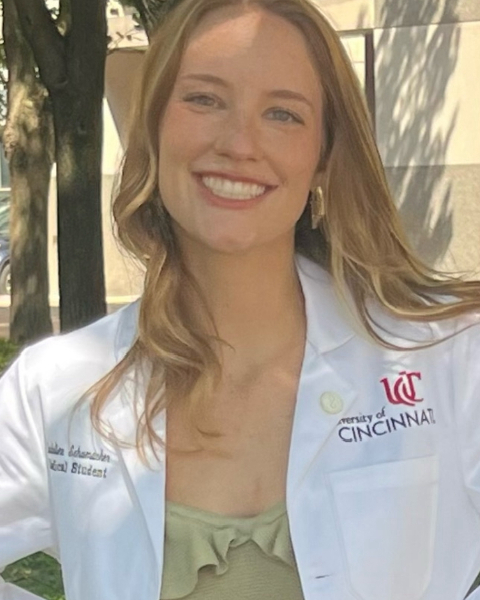QP 19 - Breast Cancer 4: Quick Pitch
1110 - Toxicity after Proton Beam Therapy for New and Recurrent Breast Cancer
Wednesday, October 2, 2024
8:10 AM - 8:15 AM ET
Location: Room 204

Madeline Schumacher, BS
University of Cincinnati College of Medicine
Cincinnati, Ohio
Presenter(s)
M. Schumacher1, T. MacDonald2, T. Meier2, S. Medek2, J. R. Kharofa2, E. C. Daugherty2, and S. M. C. Sittenfeld2; 1University of Cincinnati College of Medicine, Cincinnati, OH, 2Department of Radiation Oncology, University of Cincinnati Cancer Center, Cincinnati, OH
Purpose/Objective(s): Proton beam therapy (PBT) is a growing area of interest in breast cancer treatment due to its ability to provide reduced doses to surrounding normal tissues and the potential for decreased toxicities, particularly in cases of reirradiation. This study evaluates a single institution’s experience treating breast cancer patients with PBT, for both initial radiation treatment (RT) and reirradiation (reRT). Materials/Methods: All patients treated at a single proton center between 2017-2023 who received PBT for a breast cancer diagnosis were identified and charts were retrospectively reviewed collecting patient demographics, disease characteristics, treatment details, disease-related outcomes, and toxicities. Included patients received primary adjuvant RT or reRT to either the intact breast, chest wall, and/or regional nodal lymphatics. Both acute and late toxicities were recorded and scored. In patients with post-treatment rib fractures, CT imaging on which the fractures were visible was fused with the treatment planning scan to retrospectively collect and analyze dosimetric data of those fractured ribs. Statistical analysis was then conducted.
Results: A total of 54 patients were included, 12 receiving reRT and 42 with initial RT. Median time to reRT was 8.6 years, and 75% received previous RT for breast cancer. Median age at diagnosis was 52 years. Over 75% of patients received RT to breast/chest wall and regional nodes, with an average dose of 50 Gy in 25 fractions. 12 patients received sequential 10-16 Gy boost in 2 Gy fractions. Median follow-up time was 20 months. Of the 54 patients, 9 recurred and 5 of those had a breast cancer-specific death. All patients experienced skin toxicity; 26% grade 1, 50% grade 2, and 24% grade 3. 33% of reRT patients had grade 3 skin toxicity compared to 21% of initial PBT patients. Overall, 6 patients (11%) had a symptomatic rib fracture, at a median time of 12 mo after RT. Dosimetric analysis for these patients showed all rib fractures were in-field with a median D0.5cc of 51.08 Gy and a median average dose of 37.59 Gy to the fractured ribs. 33% of patients receiving reRT had symptomatic rib fractures compared to 5% of initial PBT patients. 48% of patients experienced grade 1 or 2 esophagitis, and 0 had grade 3 or 4 esophagitis.
Conclusion: Breast RT utilizing protons has high rates of grade 3 skin toxicity regardless of previous RT. Symptomatic rib fractures following proton irradiation may be more common than previously reported, particularly in reRT, with occurrence in up to 1/3 of patients at a median of 1 year. Asymptomatic rib fractures are likely even more common as post-treatment surveillance imaging is not routine. wide range of dose exposure was seen in the fractured ribs, suggesting that end of range uncertainty in proton irradiation likely plays a role in increased rib fracture incidence.
Purpose/Objective(s): Proton beam therapy (PBT) is a growing area of interest in breast cancer treatment due to its ability to provide reduced doses to surrounding normal tissues and the potential for decreased toxicities, particularly in cases of reirradiation. This study evaluates a single institution’s experience treating breast cancer patients with PBT, for both initial radiation treatment (RT) and reirradiation (reRT). Materials/Methods: All patients treated at a single proton center between 2017-2023 who received PBT for a breast cancer diagnosis were identified and charts were retrospectively reviewed collecting patient demographics, disease characteristics, treatment details, disease-related outcomes, and toxicities. Included patients received primary adjuvant RT or reRT to either the intact breast, chest wall, and/or regional nodal lymphatics. Both acute and late toxicities were recorded and scored. In patients with post-treatment rib fractures, CT imaging on which the fractures were visible was fused with the treatment planning scan to retrospectively collect and analyze dosimetric data of those fractured ribs. Statistical analysis was then conducted.
Results: A total of 54 patients were included, 12 receiving reRT and 42 with initial RT. Median time to reRT was 8.6 years, and 75% received previous RT for breast cancer. Median age at diagnosis was 52 years. Over 75% of patients received RT to breast/chest wall and regional nodes, with an average dose of 50 Gy in 25 fractions. 12 patients received sequential 10-16 Gy boost in 2 Gy fractions. Median follow-up time was 20 months. Of the 54 patients, 9 recurred and 5 of those had a breast cancer-specific death. All patients experienced skin toxicity; 26% grade 1, 50% grade 2, and 24% grade 3. 33% of reRT patients had grade 3 skin toxicity compared to 21% of initial PBT patients. Overall, 6 patients (11%) had a symptomatic rib fracture, at a median time of 12 mo after RT. Dosimetric analysis for these patients showed all rib fractures were in-field with a median D0.5cc of 51.08 Gy and a median average dose of 37.59 Gy to the fractured ribs. 33% of patients receiving reRT had symptomatic rib fractures compared to 5% of initial PBT patients. 48% of patients experienced grade 1 or 2 esophagitis, and 0 had grade 3 or 4 esophagitis.
Conclusion: Breast RT utilizing protons has high rates of grade 3 skin toxicity regardless of previous RT. Symptomatic rib fractures following proton irradiation may be more common than previously reported, particularly in reRT, with occurrence in up to 1/3 of patients at a median of 1 year. Asymptomatic rib fractures are likely even more common as post-treatment surveillance imaging is not routine. wide range of dose exposure was seen in the fractured ribs, suggesting that end of range uncertainty in proton irradiation likely plays a role in increased rib fracture incidence.
